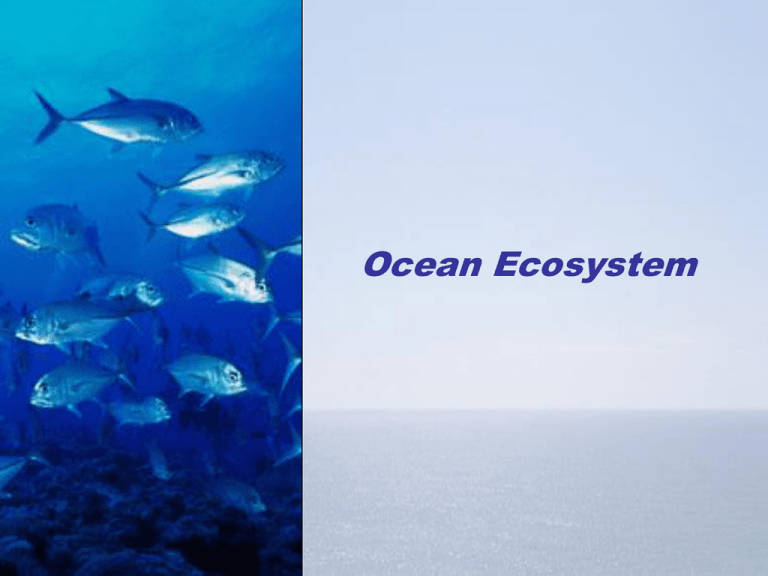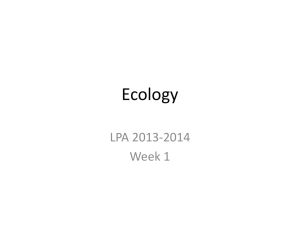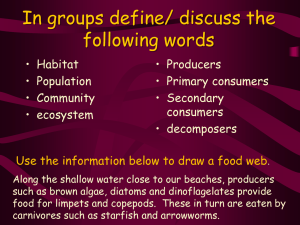File
advertisement

Ocean Ecosystem Goal: To understand the factors (both biotic and abiotic) that control the distribution and abundance of life in the oceans Ecosystem Review Ecosystem: “Any area of nature that includes living organisms and non-living substances that interact to produce and exchange of materials between living and non-living parts is an ecological system or ecosystem.” (E.P.Odum) Ecosystems consist of 4 components: abiotic, producers, consumers, and decomposers; • Ecology is the study of the interrelationships between the physical and biological aspects of the environment. -It is the study of how organisms adapt to their environment and in turn alter it. Ecosystem Review Biotic Components of the Ecosystem • • • plants animals bacteria Abiotic Components of the Ecosystem • • • geological basin shape, size, & topography physical temperature, currents, pressure, light chemical carbon, nitrogen, phosphorus, oxygen, salinity, trace metals, vitamins The Environment • The ocean water column can be separated into 2 distinct zones: the surface zone and the deep zone 1. Surface zone • extends down to about 100- 300 meters • well mixed • known as the “mixed layer” • includes the photic zone 2. Deep zone • the rest of the water column • dark and cold with much less productivity • includes the aphotic zone the pycnocline forms a physical barrier between the surface and deep zones Biozones Shelf Versus Basin Trophic Interactions • To understand ocean ecology we need to know how the autotrophic and heterotropic components are related to each other (i.e. energy transfer and exchange) we examine trophic level dynamics – trophic levels describe who eats whom From Plankton to Top Predator: Building Marine Food Webs From Energy Conversions to Food Webs (Almost) all life is based on the sun’s energy. - Sunlight enters atmosphere. - Plants turn sunlight into organic matter. - This is called primary production. - Energy flows in and out of the earth, but organic matter is recycled. Production • There are two types of organisms in any given ecosystem: autotrophs and heterotrophs autotrophs make their own food (organic matter) from inorganic nutrients (C, N, P, S, trace metals and vitamins) and either light or chemical energy, they ‘fix’ CO2 – they ‘fix’ CO2 via photosynthesis (light E) or chemosynthesis (chemical E, i.e. H2S) 6 CO2 + 12 H20 C6H12O6 + 6 H2O + 6 O2 light OR chemical E – – – autotrophs form the base of the food web (i.e. primary producers) and are ultimately responsible for all life in the world’s oceans marine examples include phytoplankton, cyanobacteria, and sulfide oxidizing bacteria (i.e. at hydrothermal vents) phytoplankton are the most abundant primary producers in the oceans Production (cont’d) • autotrophs vs heterotrophs (cont’d) – heterotrophs consume food (organic matter) that has already been produced they derive energy (ATP) from the breakdown of organic compounds via respiration C6H12O6 + 6 O2 6 CO2 + 6 H2O + ATP when there is no light (i.e. at night or in deeper waters) phytoplankton and cyanobacteria respire the organic compounds that they produced during photosynthesis examples of marine heterotrophs include all marine animals and most marine bacteria Primary Production = energy packaged into life Plankton = Drifting, tiny life in the ocean Phytoplankton = Plantlike Plankton Primary Production = Biomass built from sunlight Production (cont’d) • Productivity is high in the surface waters (i.e. photic zone), due to ample sunlight for photosynthesis, and then decreases with depth (i.e. aphotic zone) Production (cont’d) • The critical depth is where total production (PT) equals total respiration (RT): PT = RT – occurs at the 1% light level Production (cont’d) • Productivity is highest in coastal waters and upwelling zones due to higher nutrient concentrations Average Global Primary Production (Chl a) March 6-13 2001 Terra MODIS NASA/GES/DISC/DAAC Biological Productivity in the Ocean Normal conditions El Nino conditions http://www.forces.si.edu/





